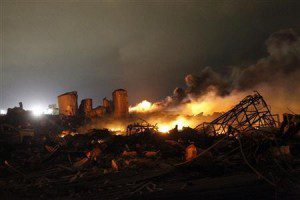
A week after a blast at a Texas fertilizer plant killed at least 15 people and hurt more than 200, authorities still don’t know exactly why the West Chemical and Fertilizer Company plant exploded.
Here’s what we do know: The fertilizer plant hadn’t been inspected by the Occupational Safety and Health Administration since 1985. Its owners do not seem to have told the Department of Homeland Security that they were storing large quantities of potentially explosive fertilizer, as regulations require. And the most recent partial safety inspection of the facility in 2011 led to $5,250 in fines.
We’ve laid out which agencies were in charge of regulating the plant and who’s investigating the explosion now.
What happened, exactly?
Around 7:30 p.m. on April 17, a fire broke out at the West Chemical and Fertilizer Company plant in West, Texas, a small town of about 2,800 people 75 miles south of Dallas. Twenty minutes later, it blew up. The explosion shook houses 50 miles away and was so powerful that the United States Geological Survey registered it as a 2.1-magnitude earthquake. It flattened homes within a five-block radius and destroyed a nursing home, an apartment complex, and a nearby middle school. According to the New York Times, the blast left a crater 93 feet wide and 10 feet deep, and the fire “burned with such intensity that railroad tracks were fused.”
The blast killed at least 15 people, most of them firefighters and other first responders.
Have fertilizer plants ever exploded before?
Yes. A plant in Sergeant Bluff, Iowa, that manufactured ammonium nitrate fertilizer — the same explosive chemical stored in West — exploded on Dec. 13, 1994, killing four people and injuring 18.
But fertilizer plants are safer now, said Stephen Slater, the Iowa administrator of the Occupational Safety and Health Administration. “All kinds of technologies have had huge improvements,” he told the Des Moines Register. “And we haven’t had any bad experiences at the plants in the 20 years since [the accident]. I’m knocking on wood.” (Slater didn’t respond to our requests for comment.)
Who regulates these fertilizer plants?
At least seven different state and federal agencies can regulate Texas fertilizer plants like the one in West: OSHA, the Environmental Protection Agency, the Department of Homeland Security, the U.S. Pipeline and Hazardous Materials Safety Administration, the Texas Department of State Health Services, the Texas Commission on Environmental Quality and the Texas Feed and Fertilizer Control Service.
Some of the agencies don’t appear to have shared information before the blast.
Fertilizer plants that hold more than 400 pounds of ammonium nitrate, for instance, are required to notify the Department of Homeland Security. (Ammonium nitrate can be used to make bombs. It’s what Timothy McVeigh used to blow up the Alfred P. Murrah Federal Building in Oklahoma City in 1995.) The West plant held 270 tons — yes, tons — of the chemical last year, according to a report it filed with the Texas Department of State Health Services, but the plant didn’t tell Homeland Security.
Carrie Williams, a Department of State Health Services spokeswoman, told ProPublica that the agency isn’t required to pass that information — which is also sent to local authorities — on to Homeland Security.
While the exact cause of the explosion is unknown, a federal official told the New York Times that investigators believed it was caused by the ammonium nitrate. The blast crater is in the area of the plant where the chemical was stored.
The plant also filed a “worst-case release scenario” report with the EPA and local officials stating there was no risk of a fire or an explosion. The scenario described an anhydrous ammonia leak that wouldn’t hurt anyone.
Did any of these agencies fail to inspect the plant when they should have?


